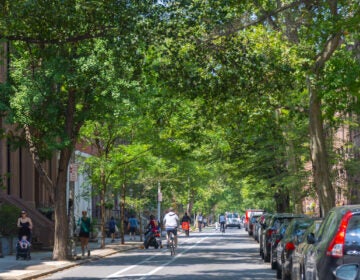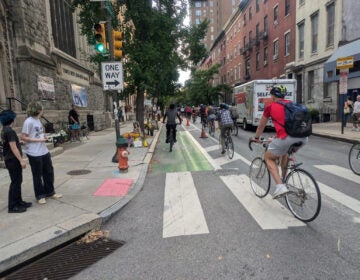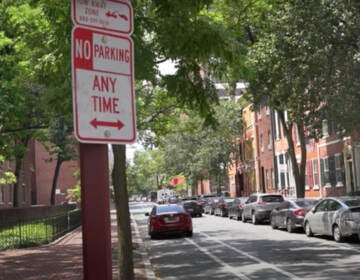Coronavirus revealed our systemic weaknesses. Bike infrastructure is one.
In the age of the coronavirus pandemic, biking infrastructure is critical for Philadelphia residents to travel safely and maintain social distancing.
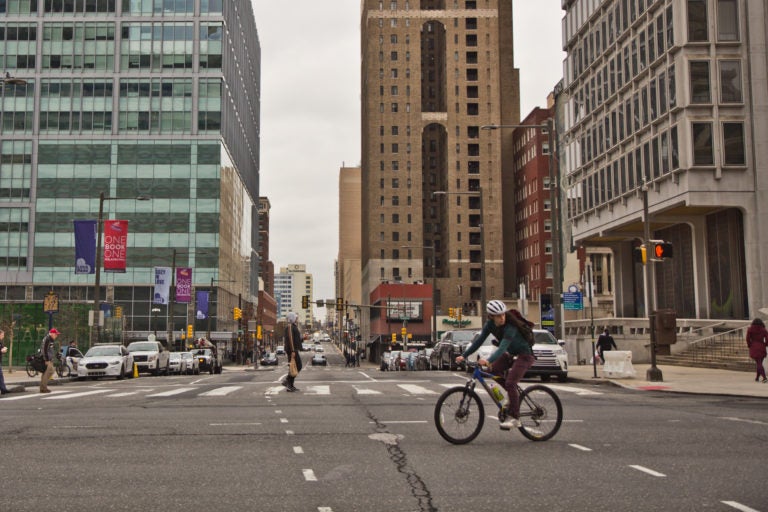
(Kimberly Paynter/WHYY)
Amid the COVID-19 global pandemic and recommendations to practice “social distancing,” a growing number of people have taken themselves off public transit and out of cabs and ride-hailing cars and gotten onto bicycles. Indego,
Philadelphia’s bike-sharing system has seen a spike in trips and restaurants are utilizing bicycle delivery services as they remain open for delivery and takeout.
In addition to those using bikes out of necessity, people are de-stressing with rides in parks and on trails.
That’s a good thing, note David Nieman, Dr.PH., a health professor at Appalachian State University and Brian Labus, Ph.D., MPH, who teaches at University of Nevada Las Vegas in Bicycling Magazine. For now, going outside is safer than staying in.
Getting together with people indoors raises the prospect of someone coughing or sneezing on your stuff, spreading the virus. Going solo, outdoors, makes you less likely to come in contact with germs, and rides longer than 30 minutes —about the distance from Fishtown to the Schuylkill River Trail — helps build your immune system.
“If you have to travel, the outdoors is a way to really dilute anything that could be around you,” Dr. Robyn Gershon, an epidemiology professor at New York University’s School of Global Public Health, told Curbed “The sunlight is also really good because it’s a natural disinfectant.”
If you are new to traveling by bike or just need a refresher course, there are some resources out there, like the Bicycle Coalition of Greater Philadelphia’s guide for beginners.
But here’s the thing: We need more than tips for beginners. Bike infrastructure providing safe passageways between neighborhoods, would better position our City now and in the case of future public health emergencies. Giving people safe access to their family members, and providing contracted delivery workers a less stressful ride to their customers, would go a long way toward improving our residents’ ability to do what they need to do amid a tremendous disruption.
All of this illustrates why city officials made the right call to add bike shops to the list of “essential businesses” that can remain open during this uncertain time.
And as long as cycling is still an essential transportation option, we need to better accommodate both the new cyclists and veteran delivery people. Here are three things Mayor Jim Kenney’s administration can do to make it easier for those Philadelphians who are choosing to make the bicycle their means of transportation during the pandemic.
Immediately begin work on pre-planned and legislated protected bike lanes and convert all high-trafficked existing curbside bike lanes into pop-up protected bike lanes.
While curbside bike lanes are safer than traditional door-zone lanes, they are also regularly blocked by private vehicles. Blocking access to illegally parked cars on these streets would allow for easier movement not just for people who bike to work, but their families and children, as well.
Among the streets where this can be done, now: South Street Bridge, Delaware Avenue, Columbus Boulevard, Spruce Street, Pine Street, 10th Street, 6th Street, 13th Street, and the Ben Franklin Parkway.
Many of these streets are already ready for upgrades; we are simply proposing that the process be sped up in the short term.
Put more PPA and PPD officers on these bike lane beats. As we’ve seen on streets with protected infrastructure, flex posts don’t stop the most egregious offenders from illegally pulling into the bike lane, forcing people on bikes, scooters, wheelchairs, and other transportation modes, into vehicular traffic. Ticketing and towing these motorists’ vehicles will both send a much-needed message to scofflaws and Philadelphians who opt to ride a bike to work during this period.
Require all buildings to allow people to bring bicycles inside. Philadelphia does not have enough bike parking on our sidewalks. And as long as some employees are continuing to go into work around the City, the City should call upon all buildings to allow bicycles inside for storage purposes.
Safety is the main reason more Philadelphians don’t travel by bike through the City. Philadelphia has a total of five miles of protected bike lanes on its 2,500-mile street grid, though we are set for 15 more by the end of this year. And while cyclists — and those who want to cycle but don’t feel safe doing so — have impatiently waited for new infrastructure to be constructed, we are now in a situation where we can’t wait. Philadelphia needs more dedicated space to safe, lower-risk travel.
Given the circumstances the world is currently in — and what’s to come — that process should be sped along now.
Randy LoBasso is the policy manager at the Bicycle Coalition of Greater Philadelphia. Ashley Vogel is the marketing and development Manager.
A version of this piece originally appeared on the Greater Philadelphia Bicycle Coalition’s website.
WHYY is your source for fact-based, in-depth journalism and information. As a nonprofit organization, we rely on financial support from readers like you. Please give today.

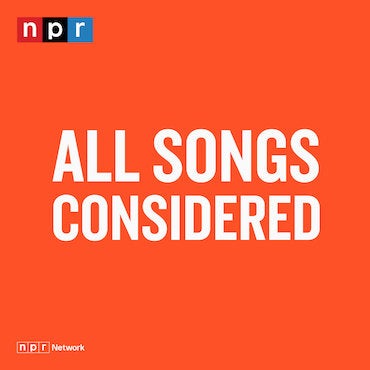



![CoronavirusPandemic_1024x512[1]](https://whyy.org/wp-content/uploads/2020/03/CoronavirusPandemic_1024x5121-300x150.jpg)
